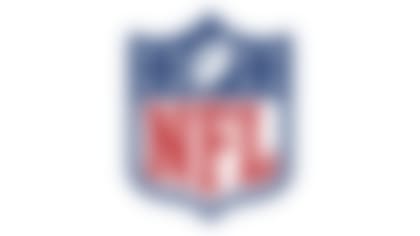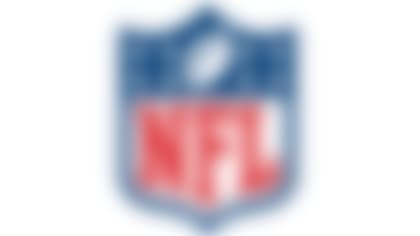We have our largest freefall in this year's Top 100, and to no one's surprise, it's injury-related.
Ladies and gentlemen, welcome Odell Beckham Jr. to the Top 100 at No. 77.
Pauses to allow for gasps and protests to simmer
I know, I know, the ranking is low. Beckham will probably follow suit by quote-tweeting the ranking with how it will motivate him. That's his right, and honestly, it's earned.
Unfortunately, that's how these things tend to go. We've already seen J.J. Watt fall into the 80s after two straight injury-plagued seasons, and Beckham is seeing something similar after appearing in just four games in 2017. The wideout suffered a gruesome ankle fracture in New York's Week 5 loss to the Los Angeles Chargers and didn't see the field again in 2017, removing him from player consciousness as others took over the spotlight in his absence.
That last part is a major factor in these rankings. As we've seen in the past (and will see in the coming weeks), recency bias plays a big part in how these things shake out. Is Beckham really the 77th best player in the league? When healthy, and from what information we have available, the definitive answer is no. He's deserving of a much higher ranking.
But we live very much in a what-have-you-done-for-me-lately society, and its favorite sport embodies that perhaps more than any other. And what Beckham has done for the Giants lately isn't much -- 25 catches, 302 yards, three touchdowns -- thanks to that injury. When projected over the course of a 16-game season, though, we're looking at a 100-catch, 1,200-yard, 12-touchdown season, which falls right in line with his stats from his three previous seasons. We're probably also looking at a better finish for the Giants than 3-13, too.
TL;DR:Odell Beckham is good -- and much better than his ranking.
As for the rest of this week's rankings (holy Titans, Batman!)...
Byard put up gaudy numbers in his first season as a full-time starter, grabbing eight interceptions and logging 16 passes defensed to go along with 87 tackles. His efforts were largely panned, though. Outside of an All-Pro selection, Byard had to wait unusually long to get his well-deserved Pro Bowl nod, serving as a second alternate for the annual all-star showcase. He even had to battle for this writer's respect ( which he earned upon further review and a revelatory sit-down in April). Another season like that will launch him up these rankings, but as a first-time entry, this seems about right.
This one is tough to explain. Sure, Peters' novelty wore off by his third season, but he's still an above-average corner. What also wore off was his welcome in Kansas City, which traded him to Los Angeles and might explain his 47-place fall. When he was a rookie, he was startlingly good. A second-year player, more of the same. But by Year Three, he was a talented but at times disruptive defensive back. His numbers are consistent, recording one fewer interception in 2017 but three more forced fumbles (four) than the season prior. The difference that jumps out is his passes defensed, which has fallen with each additional season (from 26 to 20 to nine in 2017). A change of scenery might be best for Peters, and might launch him back into the top 35 in 2019.
Nashville's favorite mustached, beer-chugging tackle sees a nine-place drop this year, despite the Titans making the playoffs (and winning a postseason game) and the offense finally allowing its future at running back to run wild late in the season. Perhaps it was DeMarco Murray's dropoff in production that caused Lewan's slight slide, but the tape doesn't lie. No matter -- Tennessee is more than happy with the play of Lewan, who finds himself in the Top 100 for the second time in as many years.
We covered a lot of this in the intro, but Beckham's ranking here is truly preposterous. Yes, he only played in four games, but other players have missed more time and suffered less. Could some of the league's players be retaliating for Beckham's diva tendencies? Might some of them want to knock him down a peg? Or did he simply fall out of consciousness? We're guessing the latter (surely professional athletes can't be so vindictive), with the hopes we aren't back here discussing such a ranking next year.
One half of the Chargers' fearsome pass rushing duo finds himself in the Top 100 for the first time in his career and it's well-deserved. Ingram recorded his second 10.5-sack season in his last three, forced one fumble and finished with his third-straight 56-plus-tackle season, capping an excellent three-season stretch. The 29-year-old is in his prime and enjoying it opposite Joey Bosa, who cracked the Top 100 after his rookie season at No. 100 last year. Not a bad pairing.
Injuries are finally starting to take their toll on one of the most feared back-end hammers in pro football. Chancellor, a safety who has missed 18 regular-season games combined over the last four campaigns, sees one of the largest slides in the Top 100, from No. 34 to 75. Perhaps his ranking is collateral damage associated with the fall of Seattle's once-vaunted defense, marked most significantly by the departures of Michael Bennett, Richard Sherman and Cliff Avril this offseason. But for a ranking taken during the season, Chancellor's potentially career-threatening neck injury, suffered just past the midpoint of 2017, seems to be the biggest factor here. On the flip side, the fact Chancellor made this ranking despite playing in just nine games last season is a testament to his lasting success. We'll soon learn whether he'll have a chance to continue it.
We should start making a flowchart for these rankings. Did your team make the playoffs? Yes. Congrats on the bump in ranking. Did they miss the playoffs? Grab your parachute. Wake posted essentially identical numbers from 2016 to 2017, yet experienced a 13-place drop as his Miami Dolphins limped to a 6-10 finish. The late-emerging veteran has put together quite a six-season stretch, but those supporting his relative slide in prestige will point to his nonexistent forced fumbles (zero) in 2017, a year after forcing five. Sure, if that's what you need. Sometimes things aren't that complicated, though.
Davis' ranking is built on years of excellence. The longtime Carolina Panther has experienced a volatile Top 100 history, falling from 54 to 89, and then jumping back up to 73 this year. It's no coincidence that in the first and last of those three years, Carolina made the playoffs. Davis, the 2014 Walter Payton Man of the Year Award winner, cemented his place in Panthers lore when he played with a broken forearm in Super Bowl 50. He's essentially sealed his place in NFL history in this decade-plus, compiling quite a career, and though his numbers dropped off a bit in 2017, this is a career achievement for a player still playing at a high level at 35 years old.
Conversely, Walker is reaping the small benefits of being on a team that made the playoffs instead of merely sniffing them the year prior. The tight end posted nearly identical numbers from 2016 to 2017 (more catches, but half as many receiving touchdowns from 2016 to 2017), yet rose three places, continuing a two-year rise (from 82 to 75 to 72). It helps to be part of a playoff team, and even more to be a consistent threat who led his team in receptions.
Ah, yes, the classic case of a reliable, productive lineman getting less shine in the second year of fame. One season after being part of the league's runaway winner for best offensive line and clearing double-wide trailer-sized holes for Ezekiel Elliott, Martin lost his right tackle to retirement and his running back to suspension and watched his Cowboys fall back to earth with a 9-7 finish. The guard experienced a similar fall (from 58 to 71), despite the fact that his play is A) difficult to quantify and B) largely the same as it's been for the duration of his career. Such is the difference between blocking for a 1,631-yard rusher and a 983-yard rusher, and a quarterback who took 25 sacks in one season and 32 the next.












